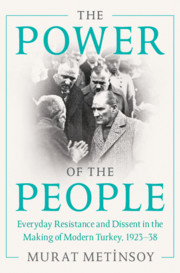Book contents
- The Power of the People
- Maps
- The Power of the People
- Copyright page
- Contents
- Figures
- Acknowledgments
- Introduction
- Part I Everyday Politics of Peasants
- Part II Everyday Politics of Urban Labor
- Part III The Power of Popular Culture
- 10 Hotbeds of Opposition to Secularism
- 11 Informal Media vs. Official Discourse
- 12 Neither Fez Nor Hat
- 13 Negotiating Anti-veiling Campaigns
- 14 Old Habits Die Hard
- Concluding Remarks
- Epilogue
- Notes
- Bibliography
- Index
12 - Neither Fez Nor Hat
Contesting Hat Reform
from Part III - The Power of Popular Culture
Published online by Cambridge University Press: 24 December 2021
- The Power of the People
- Maps
- The Power of the People
- Copyright page
- Contents
- Figures
- Acknowledgments
- Introduction
- Part I Everyday Politics of Peasants
- Part II Everyday Politics of Urban Labor
- Part III The Power of Popular Culture
- 10 Hotbeds of Opposition to Secularism
- 11 Informal Media vs. Official Discourse
- 12 Neither Fez Nor Hat
- 13 Negotiating Anti-veiling Campaigns
- 14 Old Habits Die Hard
- Concluding Remarks
- Epilogue
- Notes
- Bibliography
- Index
Summary
The Hat Law is one of the hallmarks of the early republic. The nationalist-modernist new rulers attempted to fashion the Muslim population into a modern and secular nation by changing symbolic and cultural codes like clothing styles. Symbols such as headgear had conveyed important meaning since the Ottoman Empire by signaling the wearers’ religious, social and economic status. Aware of the power of clothing and particularly of headgear, the government intervened by eliminating this traditional and religious symbol with the Hat Law. The fez was discarded and the turban was limited to preachers. However, these changes generated a series of protests. Many Islamic scholars and preachers rejected the new hat. These are well-known aspects of the people’s negative response to the hat reform. In contrast to the existing literature, which focuses on well-known anti-hat protests and the religious reasons that spurred them, this chapter examines how people dealt with the hat reform by avoidance, covert disobedience or selective adaptation methods. This chapter also reveals the complex causes of the people’s hesitance to adopt Western hats instead of rendering the issue a conflict between tradition and modernity. It reveals the role of symbols like dress codes in social resistance, power rivalries and class struggles as well as in state-making.
Keywords
- Type
- Chapter
- Information
- The Power of the PeopleEveryday Resistance and Dissent in the Making of Modern Turkey, 1923-38, pp. 234 - 243Publisher: Cambridge University PressPrint publication year: 2021

